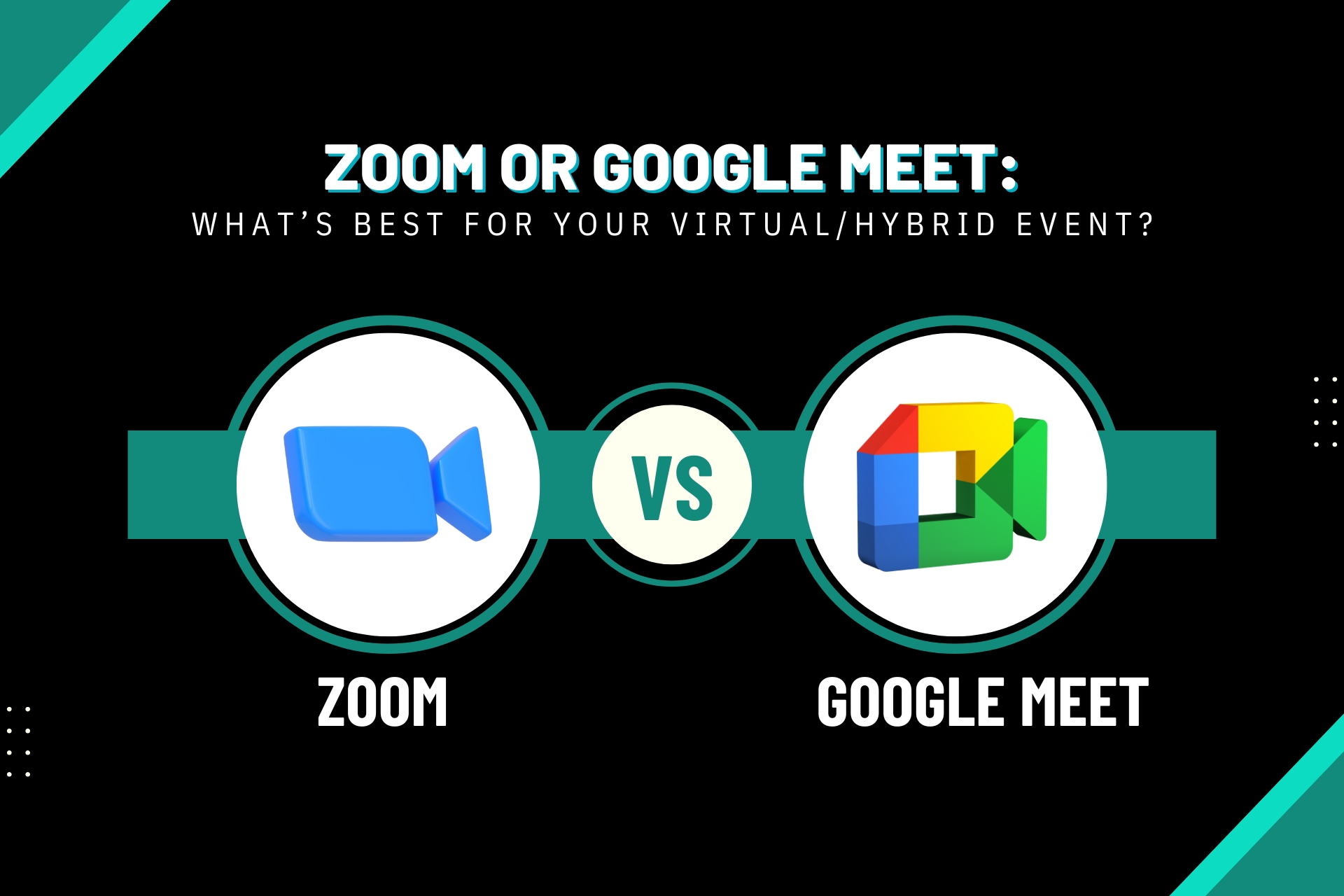Zoom or Google Meet: What’s Best for Your Virtual/Hybrid Event
In today’s fast-paced digital world, virtual events have become more important than ever. Whether it’s a business conference, a virtual meet-up, or an online class, the need for reliable video conferencing tools has skyrocketed. Two of the biggest players in this space are Zoom and Google Meet. As an event creator, you may be wondering which platform is best suited for your needs. Should you go with Zoom or Google Meet? Both are popular, but some differences can impact your decision.
To assist you in selecting the platform that is most suitable for your events, we will examine each in greater detail and present a side-by-side comparison in this blog.

Zoom vs Google Meet for Events: A Quick Overview
Both Zoom and Google Meet are well-known video conferencing tools. However, they cater to slightly different needs. With its extended lifespan, Zoom has emerged as the preferred choice for corporate gatherings, virtual conferences, and even large-scale webinars. Google Meet, on the other hand, is tightly integrated with other Google services like Gmail and Google Calendar, making it convenient for everyday users and smaller team collaborations.
When choosing between the two, the decision comes down to your specific event needs—do you need a tool that handles larger crowds with more advanced features, or something more streamlined and user-friendly?
Video Conferencing Features: Zoom vs Google Meet
When comparing the two platforms, it’s essential to look at the features they offer for video conferencing. Here’s a breakdown of some key elements you should consider.
Zoom Features
- Large Meeting Capacity: Zoom allows you to host meetings with up to 1,000 participants (with a Large Meeting add-on). This makes it ideal for larger virtual events like webinars or conferences.
- Breakout Rooms: Zoom’s breakout rooms feature is a favorite among event creators. It allows the host to split participants into smaller groups, enabling more personalized discussions or activities.
- Virtual Backgrounds: Zoom offers the ability to add virtual backgrounds, which can add a touch of professionalism or fun to your meetings.
- Webinar Mode: Zoom’s webinar feature lets you host large-scale events where attendees can watch but have limited interaction.
- Recording and Transcription: Zoom makes meeting recording and transcription possible, which might come in very handy for follow-up communications after an event.
Google Meet Features
- Integration with Google Services: One of Google Meet’s strongest features is its seamless integration with Google Workspace, including Calendar, Gmail, and Drive. Scheduling and joining meetings is incredibly easy, especially for those already using Google’s suite of tools.
- Simplicity and Ease of Use: Google Meet has a very user-friendly interface. It’s simple, clean, and easy to navigate, making it perfect for less tech-savvy participants.
- Grid View: Google Meet allows you to see up to 49 participants on the screen at once, which is excellent for larger virtual gatherings.
- Real-time Captioning: Google Meet offers real-time captioning, which is useful for accessibility and inclusivity, especially for international events.
- Data Security: Google Meet comes with built-in security measures, including encrypted video calls, making it a safe choice for hosting sensitive meetings.
Event Management Tools Comparison: Zoom or Google Meet?
When hosting a virtual event, you need to consider the specific event management tools that come with each platform. Here’s how Zoom and Google Meet stack up in this area.
Zoom’s Event Management Tools
Zoom offers a wide range of tools that make it easy to manage large events:
- Webinars: Zoom’s webinar feature lets you control who can speak, share video, or interact, while the rest of the attendees can simply watch. For sizable gatherings with hundreds or thousands of guests, this is perfect.
- Polls and Q&A: Zoom allows you to engage with your audience through polls and Q&A sessions, making it easy to get feedback or encourage participation.
- Breakout Rooms: The breakout room feature lets you divide participants into smaller groups, which can be helpful for workshops or collaborative sessions.
Google Meet’s Event Management Tools
Google Meet, on the other hand, keeps things simple:
- Integration with Google Calendar: Scheduling events in Google Meet is a breeze if you’re already using Google Calendar. You can quickly add participants, include a meeting link, and send out invites, all in one place.
- Recording: Google Meet offers recording options, but it lacks some of the more advanced event management tools that Zoom provides, like webinars or breakout rooms.
Choosing Zoom or Google Meet for Your Event: Key Considerations
Choosing between Zoom and Google Meet comes down to your specific event needs. Let’s break down some of the key factors you should consider when making your decision.
1. Event Size
If you’re hosting a large-scale event like a virtual conference or webinar, Zoom may be the better choice. It's perfect for bigger events because of its capacity for thousands of attendees and features like breakout rooms and webinars. Google Meet, on the other hand, works best for smaller virtual gatherings or meetings.
2. Features
Zoom offers a wide range of features that can enhance your event, from polls and Q&A to virtual backgrounds and transcriptions. Google Meet, while more streamlined, offers fewer features but excels in its simplicity and ease of use.
3. Ease of Use
If you’re hosting an event for participants who may not be very tech-savvy, Google Meet’s simplicity makes it the easier platform to use. Zoom, while offering more features, can sometimes be overwhelming for first-time users.
4. Cost
While both platforms offer free versions, Zoom’s paid plans offer more advanced features like webinars, larger meeting capacities, and extended time limits. Google Meet’s free version is sufficient for smaller events, but its paid version (as part of Google Workspace) offers more customization and features like longer meeting times and advanced security.
User Experience: Zoom vs Google Meet

The user experience is a key factor when selecting a platform. Both Zoom and Google Meet offer unique experiences, and your decision may depend on which one makes it easier for both you and your attendees to connect.
Zoom User Experience
Zoom’s interface is feature-rich but remains intuitive enough for most users. Setting up a meeting is simple, and once you’re in, you have access to a variety of features like screen sharing, breakout rooms, and interactive polling.
Zoom excels in larger events where features like breakout rooms and webinar mode come in handy. But, the interface can be intimidating for new users especially because it has so many functions. For event creators, Zoom provides more advanced controls and customization options.
Google Meet User Experience
Google Meet stands out for its simplicity. It’s easy to set up a meeting and joining is as simple as clicking a link, particularly if you’re using Gmail or Google Calendar. The learning curve is very low, which is why many smaller teams and individuals prefer it.
However, compared to Zoom, Google Meet lacks some of the more advanced features. For smaller virtual events, meetings, or gatherings, this isn’t usually a problem. But if you’re planning a more complex event, you may miss features like breakout rooms or webinar hosting.
Virtual Event Platforms: Which Is Best for Event Creators?
If you’re an event creator, you need a platform that not only connects people but also provides a seamless experience for both you and your attendees. Here’s a quick recap of what each platform offers to help you make the best decision:
- Zoom: Best for larger events, webinars, and conferences with a need for advanced features like breakout rooms, polls, and Q&A.
- Google Meet: Ideal for smaller gatherings or team meetings where simplicity, ease of use, and integration with Google services are more important than advanced features.
Conclusion: Best Video Conferencing Tool for Event Creators
At the end of the day, both Zoom and Google Meet are excellent video conferencing tools, but they cater to different event needs. Zoom is the better option for event creators hosting larger, more complex events with a need for advanced features. Its breakout rooms, webinar mode, and high participant capacity make it perfect for big conferences and webinars. Google Meet, on the other hand, is ideal for smaller events or meetings where simplicity and ease of use are key. Its integration with Google’s suite of tools makes it a convenient option for everyday users.
So, which one is better for your event? The answer depends on the size, complexity, and needs of your virtual gathering. If you’re hosting a large-scale event with hundreds of attendees, go with Zoom. If you need something simpler for a smaller group, Google Meet will do the trick.
At the end of the day, both platforms provide reliable video conferencing, so you can’t go wrong with either one. The choice is yours—now it’s time to pick the platform that will help you host your best virtual event yet!